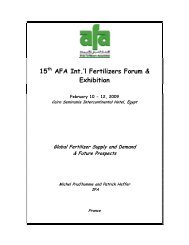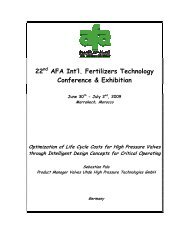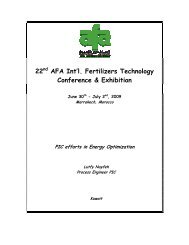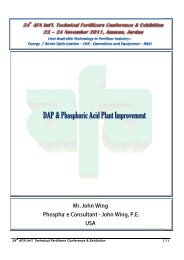Trends in Nitrogen Fertilizer Industries from a Contractor's View
Trends in Nitrogen Fertilizer Industries from a Contractor's View
Trends in Nitrogen Fertilizer Industries from a Contractor's View
Create successful ePaper yourself
Turn your PDF publications into a flip-book with our unique Google optimized e-Paper software.
Energy Consumption of Ammonia Production<br />
Stoichiometric m<strong>in</strong>imum energy consumption: = 5 Gcal/tNH3<br />
(based on Methane as feedstock)<br />
“Perfect” plant could not work <strong>in</strong> transient conditions nor partial load<br />
Waste Heat available at low temperature can not be recovered, Cool<strong>in</strong>g System to be<br />
applied<br />
Limitations <strong>from</strong> Material of Construction<br />
(e.g. Metal Dust<strong>in</strong>g; Dew po<strong>in</strong>t <strong>in</strong> flue gas)<br />
Extra energy <strong>in</strong> product (pressure / refrigeration)<br />
Incremental <strong>in</strong>vestment <strong>in</strong> further efficiency to be balanced aga<strong>in</strong>st sav<strong>in</strong>gs <strong>in</strong> energy<br />
cost<br />
AFA Annual Conference<br />
Cairo, April 2011<br />
Dr. Richard Saure<br />
Energy Consumption of Ammonia Production<br />
M<strong>in</strong>imum Energy Consumption<br />
<strong>Nitrogen</strong> fixation (i.e. NH3 synthesis) is most energy-<strong>in</strong>tensive process step for production of<br />
nitrogenous fertilizers such as Urea and Ammonium Nitrate<br />
Energy Consumption<br />
[Gcal/tNH3]<br />
10<br />
9<br />
8<br />
7<br />
6<br />
5<br />
4<br />
3<br />
2<br />
1<br />
AFA Annual Conference<br />
Cairo, April 2011<br />
Dr. Richard Saure<br />
EFMA (2000) – Best Available<br />
Technologies<br />
0<br />
1960 1970 1980 1990 2000 2010 2020<br />
Year of Plant Commission<strong>in</strong>g<br />
<strong>from</strong> literature<br />
plants <strong>in</strong> operation<br />
plants under construction<br />
actual energy consumption ≥ 6.7 Gcal/tNH3 gap due to<br />
- limited convertibility of rejected heat<br />
(2 nd law of thermodynamics)<br />
- extra energy <strong>in</strong> product (pressure / refrigeration)<br />
- optimization for plant economics<br />
m<strong>in</strong>imum energy consumption <strong>from</strong><br />
stoichiometric po<strong>in</strong>t of view = 5 Gcal/tNH3 (based on Methane as feedstock)<br />
LHV of Ammonia = 4.44 Gcal/t NH3<br />
7











